 Purdue University - Extension - Forestry and Natural Resources
Purdue University - Extension - Forestry and Natural Resources
Got Nature? Blog
The podcast series housed within the Natural Research University network delivers expert-based knowledge of natural resource management. The network is a partnership between the extension services at several land-grant university, including Mississippi State Extension Service, University of Florida Extension, Iowa State University Extension and Outreach and Purdue Extension. Funding for the project comes from the Renewable Resources Extension Act.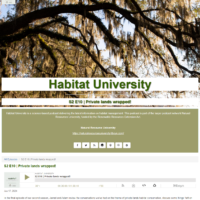
Check out the new podcast in the Habitat University, hosted by Jarred Brooke and Adam Janke, discusses the science behind wildlife habitat management and how landowners and manages can use different habitat management practices to improve their land for wildlife. This podcast is part of the larger podcast network Natural Resources University (NRU), funded by the Renewable Resources Extension Act (RREA).
In the final episode of this second season, Jarred and Adam review the conversations we’ve had on the theme of private lands habitat conservation, discuss some things “left on the bone,” and share with the listeners where Habitat University is heading in the new year! Be sure to check out the previous episodes in the podcast, including those from Season 2 discussed in this episode, and Season 1 if you haven’t already! And as always please help us improve the podcast by taking this Habitat University Listener Feedback Survey.
To listen to this episode, please visit Habitat University.
The Natural Resources University podcasts are available through the individual podcast websites, through the NRU podcast main hub or wherever podcasts are available to download.
Check out this article regarding the NRU groups award received: Purdue Forestry and Natural Resources News & Stories, Natural Resources University Podcasts Earn ANREP Gold Award .
More Resources:
Ask an Expert: Pond Management, Purdue Extension-Forestry & Natural Resources (FNR) YouTube playlist
Pond Management: Managing Fish Populations, The Education Store, Purdue Extension’s resource center
Yellow Perch Farmed Fish Fact Sheet, The Education Store
Frogs and Toads of Indiana, The Education Store
Snakes and Lizards of Indiana, The Education Store
Forest Improvement Handbook, The Education Store
Frost Seeding Native Grasses and Forbs with a Drone (UAV), Purdue Extension-FNR
Hardwood Ecosystem Experiment – Wildlife Responses to Timber Harvesting, The Education Store
Invasive Plants: Impact on Environment and People, The Education Store
Sustainable Communities, Purdue Extension
Ask the Expert: Turtles and Snakes video, Got Nature? post
ID That Tree, Purdue Extension-FNR YouTube playlist
Woodland Management Moment , Purdue Extension-FNR YouTube playlist
Jarred Brooke, Wildlife Extension Specialist
Purdue Forestry and Natural Resources
Many forest landowners own and manage their land for hunted wildlife species such as white-tailed deer, wild turkey, and a host of other game species. This presentation titled Managing Your Woods for Game Species by Jarred Brooke, Extension Wildlife Specialist for Purdue University, discusses how forest management can be tailored to enhance habitat for game species and how forest management focused on game species can provide habitat for a suite of non-game wildlife.
The Toms, Tines, and Tanagers is a webinar event hosted by the Illinois Extension, College of Agricultural, Consumer & Environmental Sciences.
Resources:
Hunting Guide for 2023-2024, Indiana Department of Natural Resources
How to Score Your White-tailed Deer, video, The Education Store, Purdue Extension Resource Center
White-Tailed Deer Post Harvest Collection, video, The Education Store
Age Determination in White-tailed Deer, video, The Education Store
How to Build a Plastic Mesh Deer Exclusion Fence, The Education Store
Managing Your Woods for White-Tailed Deer, The Education Store
Bovine Tuberculosis in Wild White-tailed Deer, The Education Store
Frost Seeding Native Grasses and Forbs with a Drone (UAV), Purdue Extension-FNR
Help With Wild Turkey Populations, Video, Purdue Extension – Forestry and Natural Resources YouTube Channel
Turkey Brood Reporting, Indiana Department of Natural Resources (IDNR)
Wild Turkey, Indiana Department of Natural Resources (IDNR)
Wild Turkey Hunting Biology and Management, Indian Department of Natural Resources (IDNR)
Subscribe to Purdue Extension-Forestry & Natural Resources YouTube Channel, Wildlife Playlist
Woodland Management Moment YouTube Playlist, Purdue Extension – FNR
Finding help from a professional forester, Indiana Forestry & Woodland Owners Association
Forest Improvement Handbook, The Education Store, Purdue Extension resource center
Jarred Brooke, Wildlife Extension Specialist
Purdue Department of Forestry and Natural Resources
Illinois Extension, College of Agricultural, Consumer & Environmental Sciences
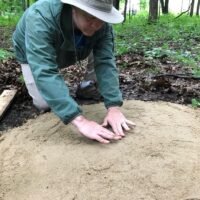
During K-12 Educator workshops, participants learn how to implement TNT curriculum such as building scent stations (pictured above). Photo by Jarred Brooke.
Agricultural & Natural Resources: Richard Louv’s words, “Time in nature is not leisure time, it’s an essential investment in our children’s health (and also, by the way, in our own),” underscores the critical role of nature in children’s well-being. Inspired by Louv’s concept of “nature deficit disorder,” The Nature of Teaching (TNT) was established in 2009 to connect youth to nature. The Nature of Teaching became an ANR signature program in 2019.
The primary focus of TNT is to engage K-12 youth with nature to foster environmental awareness and reap the positive health benefits of outdoor experiences. The program achieves this by integrating nature-based education into the school environment through standards-based curriculum. Through this, TNT not only connects students with nature but also provides lessons that align with Common Core and Next Generation Science standards.
The curriculum of The Nature of Teaching is divided into three key areas: Wildlife, Health and Wellness, and Food Waste. The Wildlife curriculum enhances students’ understanding of the natural world, while the Health and Wellness curriculum emphasizes the health benefits of connecting with nature. The Food Waste curriculum explores the environmental impact of food waste. Educators have access to more than 60 free standards-based lesson plans suitable for K-12 classrooms. In addition, TNT includes five informal curriculum units that are not standards-based and are more activity-focused. These informal lessons are great for field days and after-school type programs.

Veronica Bullock teaching a TNT lesson, Adaptations for Aquatic Amphibians, in a Union County classroom. Photo by Jennifer Logue.
Extension educators around the state have delivered TNT lessons to K-12 students since TNT became a signature program in 2019. In 2022 alone, 2,424 K-12 students benefited from TNT instruction, highlighting an impressive average knowledge increase of 16-31% in natural resources topics. The Nature of Teaching further supports K-12 educators through teacher workshops, with 17 teachers attending a workshop at Big Oaks National Wildlife Refuge in 2022. Attendees reported a significant boost in knowledge and confidence in connecting youth with nature.
As part of the signature program, Extension educators deliver three educational sessions using TNT formal curriculum to at least 15 students. Educators are also asked to provide students with pre- and post-tests to better understand student learning outcomes. Most educators deliver TNT in their local school system over several weeks. However, others deliver TNT through school clubs, after-school programs, or other avenues. The signature program requirements for Nature of Teaching are on the ANR Intranet. Educators are encouraged to work across program areas to deliver TNT.
Starting this year, The Nature of Teaching will be co-led by Jarred Brooke, Extension wildlife specialist, and Veronica Bullock, ANR educator, Franklin County. Jarred and Veronica have a long history with the TNT program and are excited to lead TNT into the future.
For educators who are interested in TNT, we will host a webinar on April 2 at 10 a.m. EDT to discuss future changes to the Nature of Teaching Signature program. You can register for the webinar here.
To see this article and others, please visit ANR Newsletter-February 2024.
Visit Nature of Teaching to learn more and explore the different lessons.
Resources:
Virtual Workshops, Nature of Teaching
Nature of Teaching, Website, Purdue College of Agriculture
The Nature of Teaching, YouTube channel
Transporting Food Waste, The Education Store, Purdue Extension resource center
Benefits of Connecting with Nature, The Education Store
Nature of Teaching: Common Mammals of Indiana, The Education Store
The Nature of Teaching: Food Waste Solutions, The Education Store
The Nature of Teaching: Food Waste and the Environment, The Education Store
The Nature of Teaching: Trees of the Midwest, The Education Store
The Nature of Teaching: Adaptations for Aquatic Amphibians, The Education Store
Trees of the Midwest Webinar, Nature of Teaching YouTube channel
Adaptations For Aquatic Amphibians Webinar, Nature of Teaching YouTube channel
Agriculture & Natural Resources (ANR)
Jarred Brooke, Wildlife Extension Specialist
Purdue Department of Forestry and Natural Resources
Veronica Bullock, ANR Extension Educator
Purdue Extension Franklin County
Purdue Extension: This Purdue Extension 2023 Impact Report features stories that highlight partnerships that have served our state’s producers, supported residents in becoming healthier, built more resilient communities and prepared Indiana’s youth to take that first step to their giant leap. We will continue to bring the science, technology and resources to all 92 counties as Indiana’s educational partner for life and as an extension of the world class institution we represent: Purdue University.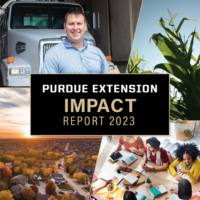
Check out the Purdue Extension-Forestry & Natural Resource highlights on the following programs:
- Todays Teens Lead the Way in Sharing Love of STEM
- Guiding Farm Families Down the Road of Succession Planning
- Providing Support for Families Through Seasons of Change
- Addressing Substance Use Recovery Together
- Workforce Development Efforts Target a Broad Range of Users
- Training International Farmers in Food Preservation and Processing
- Farmer-Driven Research Creates Solutions
Resources:
Nature of Teaching, Purdue College of Agriculture
Community Development, Purdue Extension
Purdue Extension
Family Programs, Purdue Extension – Health and Human Sciences
Taking Action to Address Substance Use in Communities (TASC), Purdue Extension
Diversified Farming and Food Systems, Purdue Extension
Woodland Stewardship for Landowners, Playlist, Purdue Extension – Forestry and Natural Resources YouTube channel
A Woodland Management Moment, FNR – Ext Playlist
Hardwood Ecosystem Experiment – Wildlife Responses to Timber Harvesting, The Education Store, Purdue Extension resource center
Forest Improvement Handbook, The Education Store
Community Planning, FNR -Ext Playlist
Wild Bulletin, Indiana Department of Natural Resources (DNR) Fish and Wildlife: Looking to build habitat that benefits wildlife species near you? February is a great time to complete winter habitat improvement projects, such as frost seeding native forbs, edge feathering forest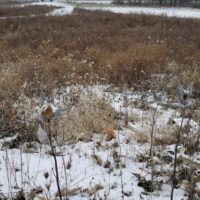 boundaries, prescribe-burning warm-season grass, and removing invasive species.
boundaries, prescribe-burning warm-season grass, and removing invasive species.
DNR’s wildlife habitat fact sheets can teach you the best techniques for your desired management practices. Need more information for your unique property? Contact your district’s Wildlife Biologist, who can meet with you to provide suggestions on wildlife habitat improvements based on your specific goals.
To learn more please visit DNR: Wildlife Habitat Fact Sheets.
Resources:
Frost Seeding to Establish Wildlife Food Plots and Native Grass and Forb Plantings – The Education Store, Purdue Extension’s resource center
Tips for Evaluating a First Year Native Grass and Forb Planting, Got Nature? – Purdue Extension-Forestry & Natural Resources (FNR)
Wildlife Habitat Hint: Tips for Evaluating a First Year Native Grass and Forb Plantings, Purdue Extension – FNR YouTube Channel
Calibrating a No-Till Drill for Conservation Plantings and Wildlife Food Plots – The Education Store
Drone Seeding Native Grasses and Forbs: Project Overview & Drone Setup, Purdue Extension – FNR YouTube channel
Drone Seeding Native Grasses and Forbs: Seed Mixing, Loading the Hopper, Programming the Route, Purdue Extension – FNR YouTube channel
Drone Seeding Native Grasses and Forbs: Recapping the Project, Purdue Extension – FNR YouTube channel
Renovating Native Warm-season Grass Stands for Wildlife, The Education Store
Forest Improvement Handbook, The Education Store
Ordering Seedlings from the State Forest Nursery System, Got Nature? – Purdue Extension-Forestry & Natural Resources (FNR)
Designing Hardwood Tree Plantings for Wildlife – The Education Store
ID That Tree – YouTube Playlist
Forest Management for Reptiles and Amphibians: A Technical Guide for the Midwest, The Education Store
Ask the Expert: Hardwood Ecosystem Experiment – Birds and Salamander Research, Purdue Extension – FNR
A Template for Your Wildlife Habitat Management Plan, The Education Store
Managing Your Woods for White-Tailed Deer, The Education Store
Woodland Stewardship for Landowners, Playlist, Purdue Extension – FNR YouTube channel
Winter Weather Tree Tips, Got Nature? Blog, Purdue Extension – FNR
Indiana Department of Natural Resources
In 2023, our FNR Extension website featured stories on topics ranging from wildlife identification, concerns in forestry, urban forestry issues and aquaculture how-to guides. Here are the top stories our FNR Extension readers were interested in last year from archival favorites to new publications on our Got Nature! blog.
FROM THE ARCHIVES – ARTICLES ORIGINALLY POSTED PRIOR TO 2023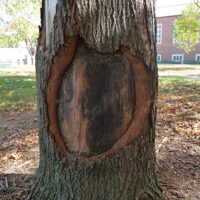
1 – Tree Wounds and Healing — Trees are incredible survivors in spite of the challenges from pests of all kinds, including us! They are vulnerable to injuries such as mechanical wounds from lawn equipment, vehicles and ice. Pruning results in an intentional wound which is of importance to consider. Tree owners and managers need to prune trees to maintain aesthetic characteristics, remove infected limbs, reduce risk, or improve structural stability. Proper pruning practice and understanding tree wounds can minimize the impact of creating wounds on trees.
2 – Question: Can Tree Roots Cause Damage to a Home’s Foundation? — A reader asked this question regarding a pin oak tree that is within 10 feet of their house after receiving A certified arborist took a look at it and said that he would like to use an Air Knife to expose the roots near the foundation (a walkout basement) to determine if the roots are causing damage and/or need to be pruned, or whether the tree needs to be removed since it is situated too close to the house.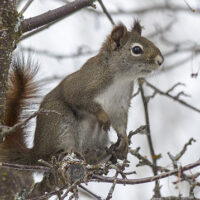
3 – Question: I Saw A Squirrel with No Fur on Its Neck, Both Backside and Underneath. What Is This? — People can be taken aback by the sight of squirrels missing hair. Sightings of partially furred squirrels is not unusual with warmer temperatures experienced through the winter. Like many wildlife issues, the cause of hair loss in squirrels is not easy to answer and often results in more questions than answers. In most situations, hair loss does not impact populations of squirrels.
4 – Be on the Watch for EHD in Deer — In August 2019, residents were warned to be on the watch for Epizootic Hemorrhagic Diseases (EHD) in deer after a white-tailed deer in Clarke County, Indiana tested positive for Epizootic Hemorrhagic Disease (EHD), and potential EHD cases had been reported in 26 other Indiana counties. Here are a few things you should know about how EHD, how to spot it, and how to report it.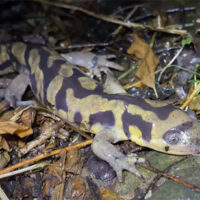
5 – Question: Are Carpenter Ants Harmful to My Tree? — Carpenter ants are very common inside trees, especially on larger, mature trees that are hollow with cavities. They nest in rotted, decayed wood, although some nests may extend into sound heartwood in the center of the tree. Carpenter ant presence is an indication of rotting wood, and infested trees should be checked to determine whether the rot has weakened the tree enough that it has become a risk of failure.
6 – Question: Why Are There So Many Acorns This Year? — If you have ever noticed acorns so numerous that you could not take a step without crushing several, you may be asking the question, “why are there so many acorns?” Some answers to this question can be found in the physiology and ecology of trees and their relationship to wildlife.
7 – It Is A Salamander. No, It Is a Lizard. Are They Different? — Salamanders are often mistaken for lizards, but the two groups are very different. Learn the differences between lizards and salamanders, how to identify each and more.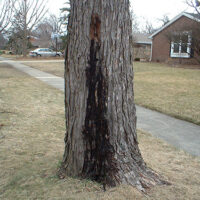
8 – Question: Blue Spruce is Dying, What Can I Do? — A reader sent in a question asking about a 40-year old spruce which is dying in the middle. There was a concern about Rhizosphaera needle cast as well as questions about fungus control sprays or alternative fungicide treatments.
9 – Slime Flux of Trees — Slime flux (also known as wet wood) is a dark, foul-smelling and unsightly seepage of sap from tree trunks. The disease is not usually a serious problem but the appearance can be alarming. Learn about the symptoms of slime flux, diagnosis and prevention measure.
10 – What Do Trees Do In the Winter? — Do they freeze up like unprotected water pipes? Or burst when it gets below freezing? Yes, the below-ground parts of a tree are kept insulated by mulch, soil and a layer of snow, and that is important to survival, but the exposed parts of a tree are not protected.
To see the full article, please visit FNR News & Stories.
Resources
Tree Pruning: What Do Trees Think?, The Education Store
Mechanical Damage to Trees: Mowing and Maintenance Equipment, The Education Store
Surface Root Syndrome, The Education Store, Purdue Extension resource center
The Nature of Teaching: Trees of the Midwest, The Education Store
Diseases in Hardwood Tree Plantings , The Education Store, Purdue Extension’s resource center
Iron Chlorosis of Trees and Shrubs, The Education Store
Purdue Landscape Report, Website
Winterize Your Trees, The Education Store, Purdue Extension resource center
Tree Defect Identification, The Education Store
Forest/Timber, Playlist, Purdue Extension – Forestry and Natural Resources YouTube channel
Urban Forestry, Purdue Extension – FNR playlist
Wendy Mayer, FNR Communications Coordinator
Purdue University Department of Forestry and Natural Resources
Videos on the Purdue Forestry and Natural Resources Extension YouTube channel received more than 213,000 views in 2023. The Top 50 videos included 47 editions of ID That Tree, an informational series by Purdue Extension forester Lenny Farlee, as well as a webinar by Farlee on How to Identify Trees in Indiana. The remaining two videos in the Top 50 were an instructional video about a common urban tree planting problem by former Purdue Extension urban forester Lindsey Purcell, and a video about the use of prescribed fire on the Hardwood Ecosystem Experiment.
Below we will count down the 10 most viewed Purdue FNR Extension videos of 2023 with a few bonus videos sure to shoot up the list in future years.
Our most viewed video in 2023 was ID That Tree: Black Walnut with a whopping 18,156 views. This video has been seen more than 28,000 times since its debut in September of 2020.
1 – ID That Tree: Black Walnut — Learn the identifying characteristics of the black walnut tree, also known as the American black walnut or eastern black walnut, including pairs of leaflets running down each stem, long running ridges on the bark, and round nuts that have a very strong exterior. This sun-loving tree also needs high quality soil.
Our second most viewed video is ID That Tree: American Elm. This video, which debuted in June 2020, was watched 16,779 times in 2023, and has been viewed 33,456 times overall.
2 – ID That Tree: American Elm — In this tree identification series you will see how American elm leaves have jagged edges with a large tooth and then smaller teeth like edges on top of it. Find out why these trees are not as easy to find as they used to be.
Number three on our most viewed list is ID That Tree: Black Oak. This video, which debuted in March 2021, was seen 5,773 times in 2023.
3 – ID That Tree: Black Oak — In this episode of ID That Tree, we continue to get to know the oak groups, this time focusing on the black oak species. Deep sinuses on the leaves and shinier coat, a dark blocky bark and acorns with loose shingle-like plates on the cap are some key identifiers to separate it from the red oak and others.
Number four on the most viewed videos list was ID That Tree: Invasive White Mulberry. This video, which debuted in September 2021, was seen 5,197 times in 2023.
4 – ID That Tree: Invasive White Mulberry — On this episode of ID That Tree, Purdue Extension forester Lenny Farlee introduces you to a non-native invasive tree that is widespread across the state, white mulberry. Key identifying characteristics to separate it from its native cousin red mulberry are shiny variable leaves and where the species grows, near fence rows, hedgerows and other waste areas. The red mulberry has larger leaves that are duller in color with a sandpapery texture, and the species is often found in the forest understory.
Fifth on our countdown of top videos of 2023 is ID That Tree: Pignut Hickory. This video, which debuted in March 2022, was seen 4,569 times in 2023.
5 – ID That Tree: Pignut Hickory — In this edition of ID That Tree, meet another member of the hickory family that can found in upland areas, the pignut hickory. This species is identifiable by its five-leaflet compound leaves, its smooth round nut and partially open husk.
Number six on our list of top videos for the year is ID That Tree: Northern Catalpa. This video, which debuted in August 2021, was watched 4,489 times in 2023.
6 – ID That Tree: Northern Catalpa – On this episode of ID That Tree, meet the Northern Catalpa, native to southern Indiana along the Ohio River bottoms. This species, which provides rot resistant wood great for outdoor usage, features beautiful flower clusters in early summer, huge heart shaped leaves in whirled formation, and long bean-like fruit pods.
Number seven on our Purdue FNR Extension most viewed list is ID That Tree: Sassafras. This video, which debuted in July 2020, was seen 4,481 times in 2023. Graduate student Olivia Bingham is researching sassafras wilt in Indiana and needs your help with possible sightings across the state.
7 – ID That Tree: Sassafras — Join Purdue Extension forester Lenny Farlee as he introduces you to the Sassafras in this edition of ID That Tree. The Sassafras is well known for the tea made from its bark and also for having a variety of shaped leaves from zero to three lobes.
Eighth on our 2023 most watched videos list is ID That Tree: Red Pine. This video, which debuted in February 2022, was seen 4,470 times in 2023.
8 – ID That Tree: Red Pine — This week on ID That Tree, Purdue Extension forester Lenny Farlee introduces you to a non-native conifer that can be found throughout the state, the Red Pine. This species, which enjoys sandy soil, is identifiable by its small, egg-shaped cones, as well as tufts of needle pairs, which can be quite brittle, and orange/reddish bark.
Number nine on our most watched list is ID That Tree: Pin Oak. This video, which debuted in December 2021, was viewed 4,100 times in 2023.
9 – ID That Tree: Pin Oak — On this edition of ID That Tree, meet a species of native Indiana oak from the broad red/black oak family, which is found in bottomlands and areas with imperfectly drained soil, the Pin Oak. This species is recognizable by round acorns with flat scales, bristle-tipped leaves with deep 90-degree angled lobes, and lower branches that angle downward.
Number 10 on our most watched list is ID That Tree: Honey Locust. This video, which debuted in October 2021, was seen 3,510 times in 2023.
10 – ID That Tree: Honey Locust — This native tree comes with its own defense system in very large thorns on the stems and trunk. Meet the honey locust. Purdue Extension forester Lenny Farlee explains that large, long yellow seed pods that resemble bean pods, the option of single or doubly compound leaves on the same tree and smooth gray bark also help identify this species.
To see the full article, please visit FNR News & Stories.
Resources:
ID That Tree, Playlist, Purdue Extension – Forestry and Natural Resources (FNR) YouTube Channel (Invasive White Mulberry, Siberian Elm, Tree of Heaven)
Invasive Species Playlist, Playlist, Purdue Extension – FNR YouTube Channel (Asian Bush Honeysuckle, Burning Bush, Callery Pear, Multiflora rose)
A Woodland Management Moment, Playlist, Purdue Extension – FNR YouTube Channel (Against Invasives, Garlic Mustard, Autumn Olive)
Woodland Stewardship for Landowners, Playlist, Purdue Extension – FNR YouTube Channel (Common Buckthorn, Japanese Barberry)
Indiana Department of Natural Resources: Invasive Species
Indiana Invasive Species Council
Cooperative Invasive Species Management Area (CISMA)
Report Invasive, Purdue Extension
Aquatic Invasive Species, Illinois-Indiana Sea Grant (IISG)
Episode 11 – Exploring the challenges of Invasive Species, Habitat University-Natural Resource University
What are invasive species and why should I care?, Got Nature? Blog, Purdue Extension – FNR
Shrubs and Woody Vines of Indiana and the Midwest, The Education Store, Purdue Extension Resource Center
Native Trees of the Midwest, The Education Store
Investing in Indiana Woodlands, The Education Store
Forest Improvement Handbook, The Education Store
Wendy Mayer, FNR Communications Coordinator
Purdue University Department of Forestry and Natural Resources
Tax preparation time usually brings with it questions about what is deductible, how to report this income, and what you can do to save on your taxes in the future. Fortunately for woodland owners, there are several excellent resources available to help you find some guidance.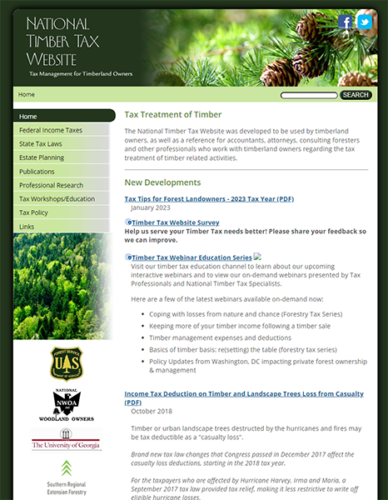
A national site addressing tax issues for woodland owners is the National Timber Tax Website. This site provides updated tax tips for the 2023 filing year, as well as many guides and references to help you effectively plan a tax strategy for your property.
The first link you will see on the National Timber Tax website is the recent timber tax tips by the U.S. Department of Agriculture (USDA), Forest Service:
Tax Tips for Forest Landowners: 2023 Tax Year (pdf 176KB)
Purdue Forestry and Natural Resources Extension offers some publications covering taxation issues for timber sales and tree planting.
How to Treat Timber Sale Income
Determining Tax Basis of Timber
Financial and Tax Aspects of Tree Planting
If you sold timber or planted trees for timber production last year, the references above may help you understand your options and possibly provide some tax savings.
Familiarizing yourself with the special treatment timber sales and tree plantings, which may be given in the tax code, can also help you more effectively plan for future tax returns.
Other resources:
U.S. Forest Service
The Education Store, Purdue Extension (place in search field: “timber”)
Lenny Farlee, Extension Forester
Hardwood Tree Improvement and Regeneration Center (HTIRC)
Forestry and Natural Resources, Purdue University
Check out the new newsletter posts available by visiting the Indiana Woodland Steward website. Stay current in the world of forestry and receive their free e-newsletter by subscribing at IWS Subscribe.
Highlights from the current Newsletter include: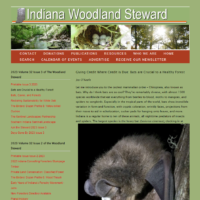
- Giving Credit Where Credit is Due: Bats are Crucial to a Healthy Forest
Joy O’Keefe
“Let me introduce you to the coolest mammalian order – Chiroptera…” - Bats, Caves, and Forests
by Carroll Ritter
“Many conservation efforts are included in management of our forest resources. Not only are we designing plans for silvicultural outcomes, but also for habitat and species…” - Restoring Sustainability for White Oak and Upland Oak Communities: An Assessment and Conservation Plan
White Oak Facts
“American white oak is a foundational tree species, currently occupying more than 104 million acres of public and private forestland …” - The Birders’ Dozen Profile 8: Yellow-billed Cuckoo
Dr. Jessica Outcalt, consulting bird biologist
“Welcome to the Birders’ Dozen! Over the next five issues we are going to continue introducing the last half of the bird species from Forestry for the Birds. The Birders’ Dozen…” - The Sentinel Landscapes Partnership
By Michael Spaulding
“The USDA, DoD, and DOI established the Sentinel Landscapes Partnership in 2013 to streamline federal assistance to landowners in areas where they have shared interests. Voluntary landowner assistance programs across the three federal agencies typically provide funding…” - Southern Indiana Sentinel Landscape to lead new Regional Conservation Partnership Program
By the Conservation Law Center
“The Southern Indiana Sentinel Landscape (SISL) partnership is excited to announce approval of a Regional Conservation Partnership Program (RCPP) for the 3.5-million-acre SISL area…” - Ask the Steward
By Dan Ernst
“Question: How many species of Ash are native to Indiana? Answer: Ash has long been a common tree of Indiana’s forests and woodlands and an important commercial timber species with a rich cultural history. The species was also commonly…”
The Indiana Woodland Steward Newsletter is a resource that’s full of a variety of valuable information to foresters, woodland owners, timber marketing specialists, woodland enthusiasts and wildlife enthusiasts. The Indiana Woodland Steward Institute (IWS) is an entity made from 11 organizations within the state including Purdue University, Indiana Department of Natural Resources (DNR), and Indiana Hardwood Lumbermen’s Association (IHLA), that works to promote best usage practices of Indiana’s woodland resources through their Woodland Steward publication.
Resources
Hardwood Ecosystem Experiment – Wildlife Responses to Timber Harvesting, The Education Store, Purdue Extension resource center
Forest Improvement Handbook, The Education Store
Invasive plants: impact on environment and people, The Education Store
Managing Your Woods for White-Tailed Deer, The Education Store
Shrubs and Woody Vines of Indiana and the Midwest, The Education Store
Birdfeeder tips, The National Audubon Society
Birds and Residential Window Strikes: Tips for Prevention, The Education Store, Purdue Extension resource center
Breeding Birds and Forest Management: the Hardwood Ecosystem Experiment and the Central Hardwoods Region, The Education Store
Managing Woodlands for Birds Video, Purdue Extension-Forestry and Natural Resources YouTube Channel
Subscribe: Deer, Forest Management, ID That Tree, Woodland Management Moment, Invasive Species and many other topic video playlists Purdue Extension-Forestry and Natural Resources YouTube Channel
Dan McGuckin, President
Indiana Woodland Steward
Dr. Brian MacGowan, Extension Wildlife Specialist
Department of Forestry & Natural Resources, Purdue University
 The Hardwood Ecosystem Experiment (HEE) just updated their newsletter for the fall/winter season. The Hardwood Ecosystem Experiment (HEE) was developed to study the effectiveness of different forest management methods in promoting successful oak and hickory regeneration and the effects of these management practices on plant and animal species. With nine partnering universities and agencies conducting research on the ecological and social impacts of long-term forest management, HEE has been an integral part of completed research for over 30 plus M.S. and Ph.D. level graduate students. The project has also employed more than 250 undergraduate and post-graduate students to conduct summer field work.
The Hardwood Ecosystem Experiment (HEE) just updated their newsletter for the fall/winter season. The Hardwood Ecosystem Experiment (HEE) was developed to study the effectiveness of different forest management methods in promoting successful oak and hickory regeneration and the effects of these management practices on plant and animal species. With nine partnering universities and agencies conducting research on the ecological and social impacts of long-term forest management, HEE has been an integral part of completed research for over 30 plus M.S. and Ph.D. level graduate students. The project has also employed more than 250 undergraduate and post-graduate students to conduct summer field work.
Newsletter topics include:
Squirrel & Small Mammal Crew
- Sarah Baker (PhD Candidate, Purdue) and three Wildlife Technicians conducted squirrel point count surveys. Camera trapping for squirrels and small mammals was also conducted.
Cerulean Warbler Crew
- Julian Grudens (MS Candidate, BSU) and Brit Nahorney (MS Candidate, BSU) worked with two Technicians to conduct aural surveys, nest searching, and mist netting.
They also collected caterpillar droppings to investigate the dietary preferences of Ceruleans.
Bat Crew
- Josie Hoppenworth (MS Candidate, UIUC) and Reed Crawford (PhD Candidate, UIUC) worked with two Technicians to conduct mist netting and find and catalogue roost trees.
Additional Work
- Longhorn beetle trapping was conducted (Purdue).
- Moth samples were collected (Drake University).
Introducing New HEE Staff
Rae Garrett – Field Coordinator
Rae began as the Field Coordinator in May 2023. Recently she graduated from Purdue University with a BS in Wildlife Biology with a minor in Insect Biology. Since then, she has worked in various temporary positions gaining experience in field work and outreach. She looks forward to assisting HEE Researchers with continuing data collection and working with Kat to reach new goals in outreach.
Kat Shay – Project Coordinator
Kat began as the Project Coordinator in September 2023. She has an MS in Environmental Science and an MPA from Indiana University, where she worked in Dr. Kim Novick’s lab on various phenology, carbon flux, oak leaf-miner, and cicada projects in Morgan Monroe and Yellowwood. She holds a BS in Environmental Science from the University of Alabama, where she worked in the Spatial Ecology Lab. She previously worked for NOAA at the Beaufort Lab in NC, conducting research on carbon flux and storage in salt marshes. Most recently she worked in the San Bernardino National Forest in southern California, managing conservation, recreation, and restoration projects. She has lived in Scotland, Germany, and all over the US and loves reading, traveling, and sports (especially soccer and rugby). She’s excited Hardwood Ecosystem Experiment Fall/Winter 2023 to join the HEE team and continue working in the forests she loves.
To view the full newsletter visit: HEE Newsletter.
If you would like to receive the HEE e-newsletter send your name, email, address and your interests to Kat Shay, forest project coordinator, at koshay@purdue.edu.
Resources:
Hardwood Ecosystem Experiment – Wildlife Responses to Timber Harvesting, The Education Store, Purdue Extension’s resource center
The Hardwood Ecosystem Experiment: Indiana Forestry and Wildlife, The Education Store
Breeding Birds and Forest Management: the Hardwood Ecosystem Experiment and the Central Hardwoods Region, The Education Store
The Hardwood Ecosystem Experiment: 2006-2016, The Education Store
Shrubs and Woody Vines of Indiana and the Midwest, The Education Store
Hardwood Ecosystem Experiment Playlist, Subscribe to Purdue Extension – Forestry and Natural Resources (FNR) YouTube Channel
Hardwood Ecosystem Experiment – Prescribed Fire, Purdue Extension – FNR YouTube
A Woodland Management Moment, Playlist, Purdue Extension – FNR YouTube Channel
Investing in Indiana Woodlands, The Education Store
Forest Improvement Handbook, The Education Store
Finding help from a professional forester, Indiana Forestry & Woodland Owners Association
Kat Shay, Forest Project Coordinator
Hardwood Ecosystem Experiment (HEE)
Purdue Forestry & Natural Resources
Recent Posts
- Report Spotted Lanternfly – Purdue Landscape Report
Posted: April 10, 2024 in Alert, Forestry, Invasive Insects, Plants, Wildlife, Woodlands - Declining Pines of the White Variety – Purdue Landscape Report
Posted: in Alert, Disease, Forestry, Plants, Wildlife, Woodlands - New Deer Impact Toolbox
Posted: April 7, 2024 in Forestry, Land Use, Plants, Publication, Safety, Wildlife, Woodlands - Help Research Chronic Wasting Disease – Wild Bulletin
Posted: April 3, 2024 in Disease, Forestry, How To, Safety, Wildlife, Woodlands - Indiana Reptiles and Amphibians – IFWOA Webinar
Posted: April 1, 2024 in Forestry, How To, Webinar, Wildlife, Woodlands - Birding through the Seasons – IFWOA Webinar
Posted: in Forestry, How To, Webinar, Wildlife, Woodlands - ID That Tree: Canada Yew
Posted: March 28, 2024 in Forestry, Forests and Street Trees, How To, Plants, Wildlife, Woodlands - How to Interact with Young Wildlife This Spring, MyDNR
Posted: in Forestry, How To, Safety, Wildlife, Woodlands - Spring Tree Preparations
Posted: March 26, 2024 in Forestry, Forests and Street Trees, How To, Urban Forestry, Wildlife, Woodlands - Tracking the Bloom
Posted: in Forestry, Forests and Street Trees, How To, Plants, Wildlife, Woodlands
Archives
Categories
- Alert
- Aquaculture/Fish
- Aquatic/Aquaculture Resources
- Ask the Expert
- Christmas Trees
- Community Development
- Disease
- Drought
- Forestry
- Forests and Street Trees
- Gardening
- Got Nature for Kids
- Great Lakes
- How To
- Invasive Animal Species
- Invasive Insects
- Invasive Plant Species
- Land Use
- Natural Resource Planning
- Nature of Teaching
- Plants
- Podcasts
- Ponds
- Publication
- Safety
- Timber Marketing
- Uncategorized
- Urban Forestry
- Webinar
- Wildlife
- Wood Products/Manufacturing
- Woodland Management Moment
- Woodlands